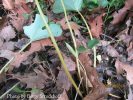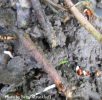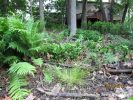Blog and photos by Betty Struckhoff (May 24)
Member and former Board member, Wild Ones – St. Louis Chapter
Master Gardener
Native gardens are not zero maintenance. But the time spent tending them really doesn’t count as work. There is so much to discover.
There are a few blemishes on my shady, moist, mostly-native backyard – three stands of non-native Pachysandra terminalis. Though not considered invasive, it forms a very thick carpet, with fibrous roots tangled in the top three or four inches of soil. It doesn’t spread by seed but still takes up space that can be put to better use.
So year-by-year I am pulling it up as I get other plants to fill in the space. This morning I was pulling it up around a nice stand of Culver’s root (Veronicastrum virginicum), some garden phlox (Phlox paniculata) and spreading ostrich fern (Matteuccia struthiopteris).
Then I noticed the foliage of blood root (Sanguinaria canadensis). It had obviously bloomed this spring because there were two or three seed pods on it. As I pulled the Pachysandra one of the pods burst open.
It was as if I had spilled a packet of unusual jewels on the moist soil. Shiny, auburn beads were bordered with a white fringe on one side. Turns out, that white fringe is called elaiosome and it is a fat-rich enticement to ants to spread the seed. Here’s a link to an interesting article about ants and all they do for woodland environments: Wonderful Woodland Ants by Aaron M. Ellison and Elizabeth J. Farnsworth
I remembered Scott Woodbury telling us that blood root seeds must be sown as soon as collected. So I covered them with a loose layer of old leaves. Maybe I will have more blood root there next spring, or maybe they will be in another place of the ants’ choosing.
I cleared another area to plant the curly wood sedge (Carex rosea) I bought at the Wild Ones booth at Shaw Nature Reserve’s plant sale. Here’s hoping next year I’ll be watching it spread.
Checking on the status of other things in the yard, I stopped to admire a butterfly (unidentified and unshot), and noticed an interesting pattern of red aphids(?) on the cup plant (Silphium perfoliatum).
A wonderful morning in the backyard!






Betty, if you have any cup plant to share, I’d love some! Linda Bennett
Lots to share for you and anyone who wants to come dig. Call me to set up time. 314 966 8404.